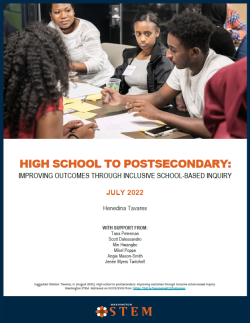High School to Postsecondary: Technical Paper 2022
Scroll down to listen to a playlist of the full report.
Washington’s students have big aspirations
Recent local research indicates that nearly 88% of high schoolers aspire to pursue some type of postsecondary education—education beyond high school in the form of a 2- or 4-year degree, apprenticeship, or certificate opportunity. And the numbers tell us that they’ll need those credentials. By 2030, more than 70% of high-demand, family-sustaining wage jobs available in our state will require postsecondary degree credentials; 68% of those will require postsecondary STEM credentials or foundational STEM literacy.
Washington’s future STEM jobs offer great promise and opportunity. But the pathways to postsecondary education aren’t always clear or accessible. Today, only 40% of all students are on track to attain a postsecondary credential. Furthermore, students of color, rural students, girls and young women, and students living in poverty still lack equitable access to these pathways—they face systemic disparities early on and fall further behind as they move through the education system.
88% of students aspire to attend postsecondary education.
Creating well-lit pathways to postsecondary credentials

What are the barriers preventing Washington’s students from attaining those postsecondary credentials? How can we better support them as they explore and navigate career pathways? What resources and supports do students need to ensure their aspirations become reality? The answers to these questions aren’t always clear. But through our recent work, we have learned a few concrete things that may help.
In a collaboration with Eisenhower High School in Yakima, and subsequent partnerships with four additional high schools, Washington STEM has learned:
- 88% of students surveyed aspire to pursue a postsecondary credential
- School staff surveyed believe 48% of students aspire to pursue a postsecondary credential—a 40% discrepancy that suggests school staff largely do not yet have enough information about pathways and students’ aspirations
- Students largely rely on teaching staff and peers to share information about dual credit and postsecondary pathways
- Students want postsecondary information early, often, and in-class: i.e., financial aid information starting in 9th grade or earlier and regular class periods (advisory/homeroom) dedicated to filling out forms and learning about pathways
Listen to the technical report:
Dual credit is a key lever we can push in order to ensure Washington students are career- and future-ready and it is vital that all students, particularly those who have historically been excluded, have access to these opportunities.
Read our technical report to learn more about student aspirations, perceptions about student interest in pursuing postsecondary credentials, and some suggestions for strengthening resource availability and support for student engagement.
Related resources
Technical Report: High School to Postsecondary: Improving Outcomes Through School-Based Inquiry
Toolkit: High School to Postsecondary Toolkit
Blog: Listening to Student Voice: Improving Dual Credit Programs
Blog: Developing Equitable Dual Credit Experiences
For press inquiries, please contact: Gloria Jordan | gloria@washingtonstem.org
